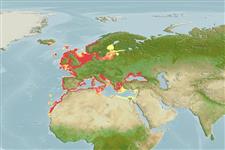Preferred temperature (Ref.
123201): 8.3 - 18.8, mean 10.8 °C (based on 1296 cells).
Índice de diversidade filogenética (Ref.
82804): PD
50 = 0.5000 [Uniqueness, from 0.5 = low to 2.0 = high].
Bayesian length-weight: a=0.00832 (0.00692 - 0.01000), b=3.10 (3.07 - 3.13), in cm total length, based on LWR estimates for this species (Ref.
93245).
Nível Trófico (Ref.
69278): 3.3 ±0.2 se; based on diet studies.
Resiliência (Ref.
120179): médio(a), tempo mínimo de duplicação da população 1,4 - 4,4 anos (K=0.19-0.3; tm=0.8-2; tmax=4).
Fishing Vulnerability (Ref.
59153): Low to moderate vulnerability (34 of 100).
Climate Vulnerability (Ref.
125649): Low vulnerability (13 of 100).
Nutrients (Ref.
124155): Calcium = 61.3 [33.3, 146.3] mg/100g; Iron = 0.399 [0.201, 0.751] mg/100g; Protein = 18.2 [16.2, 19.7] %; Omega3 = 0.68 [0.31, 1.30] g/100g; Selenium = 9.2 [4.4, 22.4] μg/100g; VitaminA = 22.1 [6.5, 68.7] μg/100g; Zinc = 0.896 [0.624, 1.317] mg/100g (wet weight);
